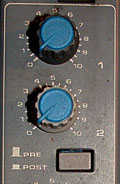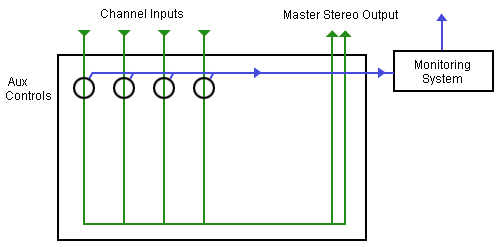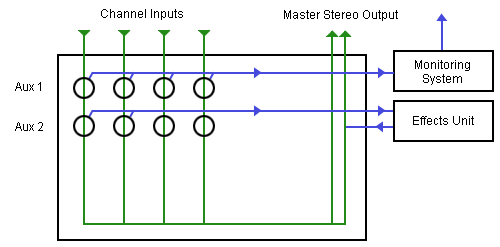Sound Mixers: Auxiliary Channels

Most sound desks include one or more auxiliary channels (often referred to as aux channels for short). This feature allows you to send a secondary feed of an input channel's audio signal to another destination, independent of the channel's main output.
The example below shows a four-channel mixer, with the main signal paths shown in green. Each input channel includes an auxiliary channel control knob — this adjusts the level of the signal sent to the auxiliary output (shown in blue). The auxiliary output is the sum of the signals sent from each channel. If a particular channel's auxiliary knob is turned right down, that channel is not contributing to the auxiliary channel.

In the example above, the auxiliary output is sent to a monitoring system. This enables a monitor feed which is different to the main output, which can be very useful. There are many other applications for auxiliary channels, including:
- Multiple separate monitor feeds.
- Private communication, e.g. between the sound desk and the stage.
- Incorporating effects.
- Recording different mixes.
Mixers are not limited to a single auxiliary channel, in fact it is common to have up to four or more. The following example has two auxiliary channels — "Aux 1" is used for a monitor and "Aux 2" is used for an effects unit.

Note that the monitor channel (Aux 1) is "one way", i.e. the channel is sent away from the mixer and doesn't come back. However the Aux 2 channel leaves the mixer via the aux send output, goes through the effects unit, then comes back into the mixer via the aux return input. It is then mixed into the master stereo bus.
Pre / Post Fader

The auxiliary output from each channel can be either pre-fader or post-fader.
A pre-fader output is independent of the channel fader, i.e. the auxiliary output stays the same level whatever the fader is set to.
A post-fader output is dependent on the fader level. If you turn the fader down the auxiliary output goes down as well.
Many mixers allow you to choose which method to use with a selector button. The example pictured right shows a mixer channel with four auxiliary channels and two pre/post selectors. Each selector applies to the two channels above it, so for example, the button in the middle makes both Aux 1 and Aux 2 either pre-fader or post-fader.
Next Page: Pan & Assign